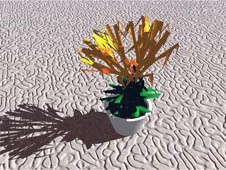Biotechnology

Is life so fragile that it can withstand no tampering? Does the
sacred brook no improvement?
- Chairman Sheng-ji Yang, (Sid Meier's Alpha Centauri)
Adam and Eve
Must have been mistaken
Science has awakened
All living things
- Vacuum, Science of the Sacred
In order to colonise alien planets a through understanding of ecology is needed, as well as large libraries of lifeforms to implant in order to set up a viable ecosystem. Thanks the Ray-Vander General Ecological Model from 2020 understanding and control of ecology has become possible (within certain limits). However, many colonies have been hampered by limitations in the gene and embryo libraries they brought with them. Some colonies deliberately did not bring with them certain animals and plants, especially drugs or pests. Nova was the first colony, and had the greatest problems with limited knowledge and library. To compensate, Novas have developed their skills quite well and have done the outmost of what they had. Gardening is a very popular hobby on Nova, and the mediterranean-like vegetation that thrives on Hope has been developed in many new directions. On other colonies animals and plants were given new uses; for example pandas have become meat animals on Atlantis. Thanks to the new contacts, biological trade has become possible and colonists can for the first time see animals and plants they only have read about ("So that is a cow?").
Bioengineering is done in many places beside Arcadia. Some changes are minor, like adapting terrestrial plants to different day lengths on Penglai. Others are more unusual, such as the Atlantean wines. Not content with traditional grapes, the Lichtenstein vineyards added genes from other plants, producing the relaxing marijuana red or rosé wines and the stimulating cocaine whites.
Arcadian Neos
Cortexture
Cortextures are biocomputers, sheets of neural tissue cultured in tanks. They are based on the neural structure of the human cerebral cortex, which is excellent at pattern recognition and associative memory. The cortextures are grown connected to computers from the start, and enable Arcadian computers to exhibit quite a bit of flexibility. Still, the biocomputer cortextures lack the feedback loops and subcortical systems necessary for consciousness and intelligence.
Another kind of cortexture is the biocontroller, essentially a small artificial but biological brain that can be used to control machines or biotech constructs. For ethical reasons they are practically never made more smart than a mouse. A common biocontroller is implanted in workers, making them better at obeying human orders.
Cortexture interfaces are a recent development: a modified cortexture is implanted into an organism or construct, and the cortexture sends out axons to connect with the nervous system or muscles. This makes it possible to add cortextures for medical use, possibly intelligence or ability enhancement and control of animals (and more worrying, humans).
Worker
Workers come in two forms, the heavy winterdigger and the lighter summerprancer. Using genetic modifications the arcadians made it possible to keep both forms around (with some effort), regardless of the climate. The winterdigger is a large armoured mole rat-like animal that digs new tunnels for the Hive and collects winterplants. Itís stats are like a bear. The summerprancer is more useful; it is light and not unlike an antelope with claws, and can fetch and carry around things, do simple houshold chores and act as messenger.
Martian Potato
A hardy plant adapted to growing in near vacuum, one of the successes of the Space Life Project. The plant is covered with a tough film, absorbing nutrients from its extensive root system and not vasting any volatiles. It lives in symbiosis with the regoformer, a droplet-shaped lichen which is able to grow on asteroid surfaces by extracting water from the regolith (this assumes there is any - it cannot survive on many asteroids, as they are more barren than any earthly desert). The Arcadians are somewhat divided over whether it would be a good idea to spread life to space itself; the Cladists oppose it, while many of the Expansionists regard it as the logical continuation of evolution and adaptation.
Symb
Symbs are small symbiotic creatures arcadians allow to live in their clothing; they come in a wide variety, from purely aesthetic living jewelry and fragrance producers over cleaning to medical symbs. One of the most advanced forms are messenger symbs: they can learn a short message (around 10 seconds worth) and be sent to find somebody else using their smell.
Living clothing
Animals or plants designed by Arcadians to act as clothing. They are little more than skin and muscles, keeping the owner warm and comfortable by their metabolism. They commonly digest dirt and skin flakes, sometimes produce pheromones, comfort the owner when in distress or act as homes for symbionts. When not in use they lie in nutrient baths.
Pets
Arcadians have developed a huge variety of pets, most with some practical uses beside being nice. Especially the lump-animals of the hives have been modified, and a variety of types exist called Schmoos, Gnurglor or Tribbles.